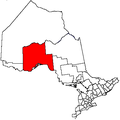Thunder Bay District
Thunder Bay District | |
|---|---|
Oliver Paipoonge (5,757) (4,906)Greenstone |

Thunder Bay District is a
.In
2016, the population was 146,048. The land area is 103,719.51 square kilometres (40,046.33 sq mi); the population density was 1.4 per square kilometre (3.6/sq mi).[1] Most of the district (93.5%) is unincorporated and part of the Unorganized Thunder Bay District
.
History
Thunder Bay District was created in 1871 by provincial statute from the western half of
large bay on the north shore of Lake Superior. Its northern and western boundaries were uncertain until Ontario's right to Northwestern Ontario was determined by the Judicial Committee of the Privy Council.[5]
Until about 1902 it was often called Algoma West from the name of the provincial constituency established in 1885.
The following districts include areas that were formerly part of Thunder Bay District:
- Rainy River, created in 1885
- Kenora, created in 1907 from Rainy River District
- Cochrane, created in 1921
Subdivisions
Municipalities
- City of Thunder Bay
- Municipality of Greenstone
- Town of Marathon
- Township of Conmee
- Township of Dorion
- Township of Gillies
- Township of Manitouwadge
- Municipality of Neebing
- Township of Nipigon
- Township of O'Connor
- Oliver Paipoonge Municipality
- Township of Red Rock
- Township of Schreiber
- Township of Shuniah
- Township of Terrace Bay
First Nations and their Indian Reserves
- Lake Nipigon
- Aroland Settlement (Aroland 83)
- Rocky Bay 1
- Bingwi Neyaashi Anishinaabek First Nation(Sand Point)
- Fort William 52
- Ginoogaming (Long Lac 77)
- Gull River 55
- Seine River 22A2
- Long Lake 58
- Namaygoosisagagun First Nation (non-status)
- Pic Mobert South
- Ojibway Nation of Saugeen First Nation (Savant Lake): Ojibway Nation of Saugeen
- Pic River 50
- Pays Plat 51
- Red Rock 53
- Seine River 23B
- Whitesand First Nation: Armstrong Settlement, Whitesand
Unorganized areas
- Shebandowan, and Upsala)
Demographics
| Year | Pop. | ±% |
|---|---|---|
2016 | 146,048 | −0.0% |
| [6][1][3] | ||
As a
census division in the 2021 Census of Population conducted by Statistics Canada, the Thunder Bay District had a population of 146,862 living in 64,601 of its 72,510 total private dwellings, a change of 0.6% from its 2016 population of 146,048. With a land area of 102,895.48 km2 (39,728.17 sq mi), it had a population density of 1.4/km2 (3.7/sq mi) in 2021.[7]
Canada census – Thunder Bay District community profile
| 2016 | 2011 | |
|---|---|---|
| Population | 146,048 (0.0% from 2011) | 146,057 (−2.0% from 2006) |
| Land area | 103,722.82 km2 (40,047.60 sq mi) | |
| Population density | 1.4/km2 (3.6/sq mi) | |
| Median age | 45.0 (M: 44.0, F: 45.9) | |
| Private dwellings | 72,551 (total) | 71,235 (total) |
| Median household income | $68,062 |
Further reading
- Arthur, Elizabeth. Thunder Bay District, 1821-1892: A Collection of Documents. Toronto: Champlain Society Publications, 1973.
See also
Wikimedia Commons has media related to Thunder Bay District, Ontario.
- Edward Island (Lake Superior)
- Esnagami Lake
- List of Ontario Census Divisions
- List of townships in Ontario
- List of secondary schools in Ontario#Thunder Bay District
References
- ^ 2011 Canadian Census. Statistics Canada. March 21, 2019. Retrieved 2012-03-20.
- ^ Highest point is 640m, located in Pukaskwa National Park. Thunder Bay is at 183m. 220 is an estimate
- ^ 2016 Canadian Census. Statistics Canada. August 12, 2021. Retrieved 2019-07-13.
- ^ Compilation of Northwestern Ontario's 2006 census data
- ^ "Ontario-Manitoba Boundary Case". Archived from the original on 2012-10-04.
- 2011census
- ^ "Population and dwelling counts: Canada and census divisions". Statistics Canada. February 9, 2022. Retrieved April 2, 2022.
- 2006 Canadian Census. Statistics Canada. August 20, 2019.
- 2001 Canadian Census. Statistics Canada. July 18, 2021.

